Chapter 4 : Neurochemistry & Psychopharmacology (Drugs and Behaviour) – Flashcards
Unlock all answers in this set
Unlock answersquestion
Ethnopharmacology
answer
Study of substances used by human societies.
question
Ethopharamcology
answer
Study of substances used by animals.
question
Drug
answer
A substance that when taken into the body, produces a systematic change in the functioning of the body. Includes: - Foods (precursors of transmitters, vitamins, etc) - Minerals (basic ions, metals like lithium etc) - Bioactive molecules synthesized by plants, animals or in lab - Toxins - Water can be considered a drug (H2O intoxication ~ Case of a radio station when Wii first came out . Station ran a promotion called hold your wee for a wii. They needed to drink 8 litres of water and the last one to go to the bathroom wins the wii. Participant died because fluids in the body were diluted. )
question
Drug delivery
answer
* Dose : Single treatment. * Dosage: Treatment regiment or regime. * Acute: Immediate * Chronic : Over time. - Drugs frequently differ in their acute vs. chronic affects. 1. Ingestion : By mouth 2. Dermal contact : Absorption through the skin. 3. Inhalation 4. Injection
question
Exocytosis
answer
Process where the synaptic vesicles combine with the synaptic membrane, spilling molecules to neurotransmitter into the synaptic cleft.
question
Binding of neurotransmitter to the postsynaptic receptors.
answer
* Neurotransmitter receptors are very picky about the substances that they will respond to. Because of this, the action of transmitters on receptors is often likened to a key opening a lock. - The various neurotransmitter receptors can all be categorized as belonging to one of two general kinds: 1. Inotropic receptors 2. Metabotropic receptors
question
Inotropic receptors
answer
Fancy ion channels (when bound by transmitter molecules), they quickly change their shape to open or close the ion channel. - The opening of the channel allows more (or fewer) of the channel's favourite ions to flow into or out of the postsynaptic neurone, thus changing the local membrane potential. - If the change in the postsynaptic membrane potential is a DEPOLARIZATION, brining the cell closer to its threshold, then it will be more likely to produce an action potential. In that case we say the synapse has an excitatory effect. - Inotropic receptor hyper polarize the postsynaptic cell, then it will be less likely to produce an action potential, and we say the synapse is inhibitory.
question
Metabotropic receptors
answer
Don't contain ion channels. - They link across the cell membrane to complicated chemical machinery inside the postsynaptic neurone. - When activated, they alter the inner working of the postsynaptic cell, using chemicals called SECOND MESSENGERS to cause changes in excitability or other, slower but larger-scale responses. E.g., the metabotropic receptor may kick off a chain of chemical reactions that will affect gene expression (the use of genes to produce proteins). These changes in gene expression can have many lasting effects, such as changes in the excitability or connections of the cell, or the production of more receptors and signalling chemicals.
question
Two major categories of transmitter receptors
answer
The 2 major categories of transmitter receptors allow not only rapid responses where timing is crucial, slower behaviours such as emotional responses, social behaviour, and so on. - The specific response of a postsynaptic neurone to molecules of transmitter is therefore determined by the particular types of receptors present on the postsynaptic membrane.
question
Principles for determining neurotransmitters
answer
1. Can be synthesized by presynaptic neurons and stored in axon terminals. 2. Released when action potentials reach the terminals. 3. Recognized by specific receptors located on the postsynaptic membrane. 4. Causes changes in the postsynaptic cell. 5. Blocking its release interfere w/ the ability of the presynaptic cell to affect the postsynaptic cell. * The brain contains many different neurotransmitters.
question
Amino acid neurotransmitter and Peptide neurotransmitter (or neuropeptides)
answer
Based on single amino acid molecules or on short chains of amino acids (called peptides), respectively.
question
Family of amine neurotransmitters
answer
* Includes some of the best-known classical transmitters (such as acetylcholine, dopamine, and serotonin).
question
Gas neurotransmitters
answer
Soluble gases that diffuse between neurons to alter ongoing processes.
question
Studying the brain
answer
* Studies of brain sections stained have shown that transmitters are found in complex networks of neurons that extend through the brain. * Each of these amine neurotransmitters is carried by different set of axons, and those axons project to different brain regions.
question
Amino acids
answer
The most common transmitters in the brain. * Two best studies are: 1. GLUTAMATE = The most widespread excitatory transmitter in the brain). 2. Gamma-aminobutyric acid (GABA) = The most widespread inhibitory transmitter. * Both have wide-ranging effects at synapses throughout the central nervous system, and from an evolutionary perspective they are among the most ancient transmitter substances.
question
Glutamate
answer
Interacts w/ several subtypes of receptors. - Activation of AMPA receptors (the most plentiful receptors in the brain) has rapid excitatory effects. - NMDA receptors = another subtype of glutamate receptors, with unique characteristics that suggest they play a central role in memory formation.
question
GABA A receptors
answer
* Received decades of special scrutiny because of their relationship to anxiety relief. * Ionotropic ; when activated, they allow more Cl - ions to flow into the postsynaptic cell, thus inhibiting that cell's activity. * Drugs that mimic this action of GABA A tend to be effective calming agents because they produce a widespread decrease in neural activity. * Drugs called BENZODIAZEPINES - e.g., Valium (diazepam) and Ativan (lorazepam) = widely used to reduce anxiety, as well as to aid muscle relaxation, sleep induction, and the like.
question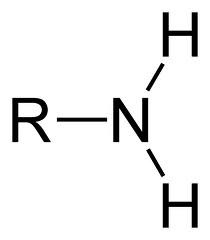
Amines

answer
A large family of nitrogen-containing compounds related to ammonia, often derived from an amino acid. * They have been implicated in many categories of behaviour and pathology. * They are involved in a wide range of disorders - Parkinson's disease, schizophrenia, Alzheimer's disease, and depression - amine neurotransmitter mechanisms are a major target for drug development.
question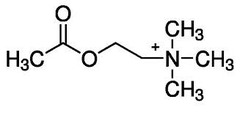
Acetylcholine (ACh)

answer
* Plays a major role in transmission in the forebrain. * Many cholinergic (ACh - containing) neurons are found in nuclei within the basal forebrain. * These cholinergic cells project widely in the brain, to sites such as the cerebral cortex, amygdala, and hippocampus. * Wide spread loss of cholinergic neurons is associated with Alzheimer's disease, and experimental disruption of cholinergic pathways in rats interferes w/ learning and memory.
question
Dopamine

answer
* Critically important for many aspects of behaviour 1 . MESOSTRIATAL PATHWAY = originates in and around the substantial migra of the midbrain. From there, axons project to parts of the basal ganglia. - When people lose a significant number of mesostriatal dopaminergic neurons, from either exposure to poisons or just old age, they develop the profound movement problems of Parkinson's disease, including tremors. 2. MESOLIMBOCORTICAL PATHWAY = Originates in the midbrain, in a region called the central segmental area (VTA). From there, the pathway projects to various locations in the limbic system and cortex. - Appears to be especially important for the processing of reward; it's probably where feelings of pleasure arise. It makes sense that the mesolimbocortical dopamine system is important for leaning that is shaped by positive reinforcement (which usually involves a reward), especially via the D2 dopamine receptor subtype. - Abnormalities in the mesolimbocortical pathway are associated with someone the symptoms of schizophrenia.
question
Serotonin
answer
Fewer in the brain than dopamine. * Serotonin (5 - HT, 5-hydroxytryptamine) participates in the control of all sorts of behaviours: mood, vision, sexual behaviour, anxiety, sleep, and many other function. * Drugs that either directly mimic serotonin, like Prozac, cause serotonin to accumulate are often effective for relieving depression and anxiety. The precise behavioural action of serotonergic drugs depend on which of the many 5-HT receptor subtypes are affected.
question
Norepinephrine
answer
Many of the brain's noradrenergic neurons have their cell bodies in two regions of the brainstem and midbrain: the locus coeruleurs ("blue spot") and the lateral tegmental area. * Noradrenergic axons from these regions project broadly throughout the cerebrum, including the cerebral cortex, limbic system, and thalamic nuclei. * Participate in the control of behaviours ranging from alertness to mood to sexual behaviour.
question
Peptides
answer
* Very important singling chemicals in both the brain and in the other organs of the body. 1. Opioid peptides = Peptides that mimic the actions of opiate drugs like morphine including met-enkephalin, leu-enkephalin, beta-endorphin, dynorphin A. 2. Like morphine, the peptides act in the brain to reduce our perception of pain. 3. A variety of peptides originally discovered in the periphery, and especially in the organs of the gut, are also made by neurones in the spinal cord and brain. These peptides may act as synaptic transmitters. 4. A variety of peptide hormones, such as oxytocin and vasopressin, are produced by the hypothalamus and pituitary. Peptides are involved in an astonishing range of functions; vasopressin was first known for its role in urine production but it also contributes to such high-level processes as memory and pair-bonding.
question
Gas Neurotransmitters
answer
* Neurons sometimes use certain gas molecules to communicate information; the best studied of these is nitric oxide. * Carbon monoxide also serves as a transmitter in some cells. Although we call them gas neurotransmitters, these substances are different from traditional neurotransmitters in at least three important ways: 1. Gas transmitter is produced outside axon terminals, especially in the dendrites, and is not held in vesicles; the substance simply diffuses out of the neurone as it is produced. 2. No receptors in the membrane of the target cell are involved. Instead, the gas transmitter diffuses into the target cell to trigger second messengers inside. 3. This gases can function as RETROGRADE transmitters: by diffusing from the postsynaptic neuron back to the presynaptic neuron, a gas transmitter conveys information that is used to physically change the synapse. This process can be crucial for memory formation.
question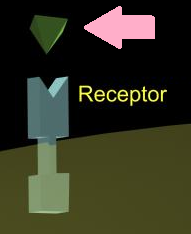
Ligand

answer
Any substance that binds to a receptor. - The natural ligands for receptors are molecules of neurotransmitters. Many (but not all) drugs that affect the brain are also receptor ligands.
question
Drugs
answer
* A medicine used in the treatment of a disease. * Many psychoactive drugs (compounds that alter the function of the brain and thereby affect conscious experiences) fall into this category, and they may be useful in psychiatric settings. * Some psychoactive drugs are used recreationally, with varying degrees of risk to the user; there are sometimes referred to as drugs of abuse. Some affect the brain by altering enzyme action or modifying other internal cellular processes , most drugs of interest in neuroscience are receptor ligands. * A combination of affinity and efficacy (where it binds and what it does) that determines the overall action of a drug.
question
Drug action
answer
Most neuroscience-active drugs exert their effects directly or indirectly via RECEPTOR PROTEINS
question
Receptor Proteins
answer
1. Ionotropic (AKA ligand-gated ion channels) : A channel protein is selected for a certain protein and that channel has an internal gate. When a ligand binds to a receptor site, it causes the gate to pop open. It is a gate that is gated by a ligand. - Fast - Has a smaller effect 2. Metabotropic (GPCR - G protein coupled receptor) : Have 7 membrane spanning domains. They go through the membrane 7 x. When bound by a molecule of transmitter, it activates an internal g- protein that starts a certain messenger. 3. Ligands : A drug or hormone that selectively bings to a receptor.
question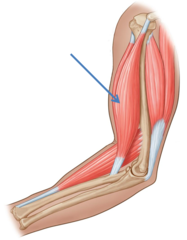
Agonists

answer
Drugs that mimic or potentiate the actions of a transmitter. - A substance that mimics the normal action of a neurotransmitter on its receptors by binding the receptors and activating them is thus a receptor agonist.
question
Antagonists
answer
Drugs that reduce the normal actions of a neurotransmitter system. * Endogenous (Made within the body) - Drugs classified as receptor antagonists bind to receptors but don't activate them, instead, they block the receptors from being activated by their normal neurotransmitter. - Drugs with this action are sometimes called RECEPTOR BLOCKERS. - Some drugs (e.g., caffeine, opium, nicotine, and cocaine) originally evolved in plants, often as a defence against being eaten. - Other modern drugs are synthetic (human made) and tuned to target specific transmitter systems. - Ativan enhance GABA neurotransmission; classic antipsychotics like Haldol block dopamine receptors; selective serotonin reuptake inhibitors like Prozac are antidepressants. - So to understand how drugs work, we must perform analyses at many levels from molecules to anatomical systems to behavioural effects and experiences.
question
Subtype of serotonin receptors
answer
More than a dozen different subtypes of serotonin receptors. - Some are inhibitory, some excitatory, some ionotropic, some metabotropic, the only thing they all really share is that they are normally stimulated by serotonin. They even differ in their anatomical distribution within the brain. - Selectively activating or blocking specie subtypes of receptors can produce diverse effects, some of which are beneficial. - Drugs that selectively block 5-HT 2 receptors while ignoring other subtypes of serotonin receptors produce a powerful and specific anti-nausea effect that brings relief to people undergoing cancer chemotherapy.
question
Effects of a drug depend on its dose
answer
* The tuning of drug molecules to receptor subtypes is not absolutely specific. *A particular drug will generally bind strongly to one kind of receptor, more weakly to a few others types, and not at all to many others. * Administering larger doses of a drug ultimately increases the proportion of receptors that are bound and affected by the drug. - In certain limits, this increase in receptor binding also increases the response to the drug; greater doses tend to produce greater effects.
question
Binding Affinity
answer
Chemical attraction. * At low doses, when relatively few drug molecules are in circulation, drugs will preferentially bind to their highest-affinity receptors. * Higher doses, enough molecules of the drug are available that they can bind to both the highest-affinity receptors and lower-affinity ligands: they bind only comparatively weakly to their receptors, so they can rapidly detach a moment later, allowing the synapse to reset in preparation for the next presynaptic signal. * Once it's bound to a receptor, a drug molecule has a certain propensity to activate the receptor; this propensity is referred to as its efficacy. * Binding triggers a chain of cellular events, but it's usually temporary, and when the drug (or transmitter) break away from the receptor, the receptor resumes its unbound shape and functioning.
question
Dose-response curve (DRC)
answer
When plotted as a graph, the relationship between drug doses and observed effects, typically taking the sigmoidal shape. - Careful analysis of DRCs reveals many aspects of a drug's activity, such as useful and safe dose ranges and it is one of the main tools for understanding the functional relationships between drugs and their targets.
question
Benzodiazepine
answer
- Example: Aravan + Xanax + Valium - They let the increase of Cl- in the membrane. - There are GABA - A and BDZ receptors. When we consume the drug that contains GABA and BDZ and they bind to the receptors. This causes the cell to open up more the allow the increase of Cl- resulting in hyper polarization. This is how these drugs work. - The BDZ inverse agonist blocks the BDZ receptors.
question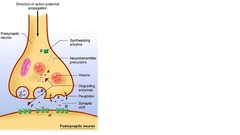
Summary of Presynaptic Drug Effects

answer
1. Altering axonal transport = Movement of materials in the axon. Could be molecules of the enzyme etc. - Colchicine : Stops this occurrence. 2. Alters in synthesis = 3. Alters in storage 4. Alters in release 5. Alters in reuptake 6. Alters in breakdown
question
Summary of Postsynaptic Drug Effects
answer
1. Inhibit monoamines oxidates = Inhibits the breakdown enzymes (agonist effect because the enzymes stay out there longer than usual) 2. Direct effect on receptors = Drugs that may bind to receptors and is recognize + activates receptor. - Can also block receptors (antagonist effect)
question
Administration of drug doses
answer
The amount of a drug that gets to the brain, and how fast it gets there, depends in part on the drug's route of administration. * Some routes (such as smoking or intravenous injection) rapidly ramp up the amount of drug that is bioavailable. * With other routes, such as ingestion (swallowing), the concentration of drug builds up more slowly over longer periods of time. * Duration of a drug effect = depends on how the drug is metabolized and excreted from the body (via the kidneys, liver, lungs, or other routes).
question
Bioavailable
answer
Free to act on the target issue, and thus not in use elsewhere or in the process of being eliminated.
question
Biotransformation
answer
The metabolites of drugs are themselves active . - Can produce substances w/ beneficial or harmful actions.
question
Pharmacokinetics
answer
The factor that affect the movement of a drug into, through, and out of the body are collectively.
question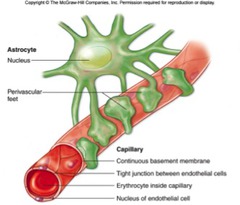
Blood-brain barrier

answer
* Blood brain barrier = protective mechanism * Tight junctions between the cells of the walls of blood vessels a blood-brain barrier that inhibits the movement of larger molecules out of the bloodstream and into the brain. * The barrier poses a major challenge for neuropharmacology because many drugs that might be useful are too large to cross the blood-brain barrier into the brain. * To an extent this problem can circumvented by administering the drugs directly into the brain. * Some drugs can take advantage of active transport systems that normally move nutrients out of the bloodstream and into the brain. * In the CNS, the junctions between the endothelial cells of blood vessel wall are much tighter - drugs can't leak out. This blood-brain barrier - a protective mechanism - neurones don't regenerate, so they must be protected from infections etc. * Gases diffuse, as do ions and small molecules and some fat-soluble molecules. Many drugs don't penetrate the BBB. - E.g., Antibiotics : They can't pass through the blood-brain barrier.
question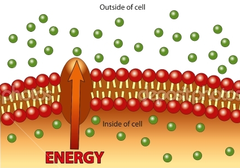
Active Transport

answer
Mechanism to convey amino acids + glucose to cells. - Many amino acids are too big to pass through the amino acids therefore you would sometime have a pump the allows us to transport it around. - Drug may be picked up by the transports to be brought into the brain for e.g.,
question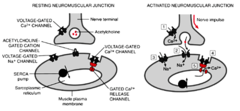
Repeated treatments

answer
Bodies = equipped to maintain a constant internal environment, optimized for cellular activities. - Body systems may change to counteract challenges such as drug treatments.
question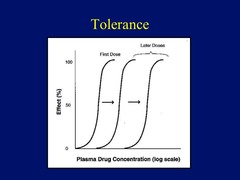
Drug tolerance

answer
Evident when a drug's effectiveness diminishes over repeated treatments. - Successively larger and larger doses of drug are needed to cause the same effect.
question
Metabolic tolerance
answer
Especially metabolic organs, such as the liver with its specialized enzymes. * More effective at eliminating the drug from the bloodstream before it can have an effect.
question
Functional tolerance
answer
Target tissue can change its sensitivity to the drug. - An important way in which a cell develops functional tolerance is by changing how many receptors it has on its surface.
question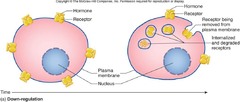
Down-regulate

answer
After repeated doses of an agonist drug, neurons neurons can decrease the number of available receptors to which the drug can bind thereby becoming less sensitive and countering the drug effect. - If the drug is an antagonist, target neurons may instead up regulate (increase the number of receptors).
question
Up-regulate
answer
Increase the number of receptors.
question
Cross-tolerance
answer
Tolerance to a particular drug often generalizes to other drugs of the same chemical class. - E.g., people who have developed tolerance to heroin tend to exhibit a degree of tolerance to all the other drugs in the spate category, including codeine, morphine, and methadone. All those drugs act on the same family of receptors.
question
Synaptic transmission
answer
Involves a complicated choreography of the two participating neurons, and drugs that affect the brain and behaviour may act on either side of the synapse.
question
Alter presynaptic processes
answer
Changing the system that converts an electrical signal (an action potential) into a chemical signal (secretion of neurotransmitter). * The most common presynaptic drug effects can be grouped into 3 main categories = 1. Effects on transmitter production 2. Effects on transmitter release 3. Effects on transmitter clearance
question
Transmitter Production
answer
* In order for the presynaptic neurone to produce neurotransmitter, a steady supply of raw materials and enzymes must arrive at the axon terminals and carry out the needed reactions. * Drugs = available that alters this process in various ways. - E.g., drugs may inhibit enzymes that synthesize a transmitter, resulting in depletion of the transmitter. * Drugs that block axonal transport prevent raw materials from reaching the axon terminals in the first place, could also cause the presynaptic terminal to run out of neurotransmitter. * Affected presynaptic neurones are prevented from having their usual effects on postsynaptic neurones, with sometimes profound effects on behaviour. * A third class of drug doesn't prevent the production of transmitter but instead interfere with the cell's ability to store the transmitter in synaptic vesicles for later release. - Effect on behaviour may be complicated, depending on how much transmitter is able to reach the postsynaptic cell.
question
Transmitter Release

answer
Transmitter is released when action potentials arrive at the axon terminal and trigger an inflow of calcium ions. * A number of drugs + toxins can block those action potentials from ever arriving. * Compounds that block sodium channels prevent axons from firing action potentials, shutting down synaptic transmission w/ deadly results. * Drugs called CALCIUM CHANNEL BLOCKERS = block the calcium influx that normally drives the release of transmitter into the synapse. - Active ingredient in Botox (specifically blocks ACh release from axon terminals near the injection site) = resulting local paralysis of underlying muscles reduces wrinkling of the overlying skin, but it may also interfere with the ability to make faces.
question
Altering transmitter release
answer
To modify the systems that the neurone normally uses to monitor + regular its own transmitter release.
question
Autoreceptors
answer
Presynaptic neurone use this to monitor how many transmitters they have released, it's a kind of feedback system. * Drugs that stimulate these receptors make a false feedback signal, prompting the presynaptic cell to release less transmitter. * Drugs that block auto receptors prevent the presynaptic neurone from receiving its normal feedback, tricking the cell into releasing more transmitter than usual.
question
Transmitter Clearance
answer
After action potentials arrive at the axon terminal + prompt a release of transmitter substance, the transmitter is rapidly cleared from the synapse by several processes. * Getting rid of used transmitters = an important step cuz new releases of transmitter from the presynaptic side won't be able to have much extra effect. * Researchers think that under certain conditions, neurones may be too good at clearing the used transmitter + a significant lack of transmitter in certain synapses may contribute to disorders like depression.
question
Reuptake inhibitors
answer
- Block the presynaptic system that normally reabsorb transmitter molecules after their release - The blocking action lets transmitter molecules to accumulate in the synaptic cleft + have a bigger effect on the postsynaptic cell. - Other drugs get a similar result by blocking the enzymes that normally break up molecules of neurotransmitter into inactive metabolites allowing the transmitter to accumulate, having a greater effect on the postsynaptic cell.
question
Selective Receptor Antagonists
answer
Bind directly to postsynaptic receptors + block them from being activated by their neurotransmitter. E.g., Curare : blocks the nicotinic ACh receptors found on muscles, resulting in immediate paralysis of all skeletal muscles, including those used for breathing. * Bind to specific receptors and activate them, mimicking the natural neurotransmitter at those receptors. * These drugs = often potent with effects that vary depending on the particular types of receptors activated. E.g,. LSD : Produce bizarre visual experiences through strong stimulation of a serotonin receptor subtype found in visual cortex.
question
Neurotransmitter binding
answer
When bonded to their matching receptors on postsynaptic membranes, neurotransmitters can make a variety of changes in the postsynaptic cell, the activation of genes, + the production of various proteins. * The intracellular processes present additional targets for drug action. E.g., some drugs induce the postsynaptic cell to up-regulate its receptors, changing the sensitivity of the synapse. Other drugs cause a down-regulation in receptor density.
question
Major categories of Psychoactive Drugs : 1. Antipsychotics
answer
* Act as selective antagonists of dopamine D, receptors in the brain. * Good at relieving the symptoms of schizophrenia that a dopaminergic model of the disease became dominant.
question
Atypical Anti-Psychotics
answer
* Have been developed that have both dopaminergic + additional, nondopaminergic actions, especially the blockade of certain serotonin receptors. - These drugs may be helpful in relieving symptoms that are resistant to the typical antipsychotics.
question
Antidepressants
answer
* Disturbances of mood = affective disorders are among the most common of al psychiatric complaints. * Reduce synaptic activity by blocking receptors. * Act to increase synaptic transmission.
question
Monoamine oxidase (MAO)
answer
Earliest antidepressants. * These inhibitors block the enzyme responsible for breaking down monoamine transmitters like dopamine, serotonin, and norepinephrine. This allows transmitter molecules to accumulate in the synapses with an associated improvement in mood.
question
Tricyclic antidepressants
answer
Block the reuptake of serotonin and norepinephrine, while selective serotonin reuptake inhibitors (SSRIs) act specifically at serotonergic synapses.
question
Anxiolytics
answer
Sever anxiety, in the form of pain attacks, phobias (specific irrational fears) and generalized anxiety, can spiral out of control and become disabling. * Anything that reduces or depresses the excitability of neurones tends to counter these states, which explains some of the historical popularity of depressants (e.g., alcohol and opium) * These substances = burdened w/ strong potential for intoxication and addiction, so they aren't suitable for therapeutic use.
question
Barbiturate drugs
answer
* ANXIOLYTICS (anti anxiety drugs) * Originally developed to reduce anxiety, promote sleep + avoid epileptic seizures. - Used occasionally for those purposes, but they are also addictive + may to overdose on, often fatally.
question
Benzodiazepines
answer
- Most heavily prescribed anti anxiety drug. - More specific + safer although they still cary some risk of addiction. - E.g., Valium and Ativan - Bind to specific sites of GABA A receptors + enhance the activity of GABA. Because GABA A receptors = inhibitory, benzodiazepines help GABA to make larger inhibitory postsynaptic potentials than GABA would produce alone. - Net effect = a reduction in the excitability of neurons.
question
Opium
answer
Extracted from poppy flower seedbeds, has been used by humans since at least the Stone age.
question
Morphine
answer
Major active substance in opium, is a very effective analgesic (pain killer) that had brought relief from sever pain to many millions of people. - It produces powerful feelings of euphoria, morphine also has a strong potential for addiction.
question
Opioid Receptors
answer
Like morphine, heroin, and codeine bind to specific receptors that are concentrated in different regions of the brain.
question
Periaqueductal gray
answer
Especially important, because it's here that opiates exert their painkilling effects.
question
Endogenous opioids
answer
Morphine like compounds made in the brain. 3 major families : 1. Enkephalins 2. Endorphins 3. Dynorphins
question
3 main kind of opioid receptors
answer
1. Delta 2. Kappa 3. Mu - Metabotropic receptors. - Powerful drugs that block opioid receptors can rapidly reverse the effects of opiates and rescue people from overdose.
question
Opiate Antagonists
answer
Block the rewarding aspects of drugs like heroin, so they can be helpful for treating addiction.
question
Tobacco
answer
WHERE did it come from ? : Native to the Americas. HOW did it become popular ?: Became more widespread following technological innovations that made it easier to smoke in the form of cigarettes. *WHAT is in it/ WHAT does it do ?: NICOTINE : Enters the blood and brain much more rapidly from cigarettes than does nicotine from other tobacco products. - Acts as a STIMULANT (increases heart rate, blood pressure, digestive action and alertness. All this makes tobacco use pleasurable. Prolonged use = very unhealthy. * WHO does it affect ? : All people but smoking and nicotine exposure in adolescence has a lasting impact on attention and cognitive development, likely as a consequence of impairments of glutamatergic synapses in the prefrontal cortex.
question
Nicotine receptors
answer
WHAT does it do? : Drive the contraction of skeletal muscles, and the activation of various visceral organs, but they are also found in high concentrations in the brain, including the cortex. - Stimulates the ventral segmental area to exert its rewarding/addicting effects.
question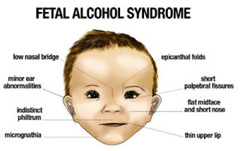
Fetal Alcohol Syndrome

answer
WHAT causes it ? : * Alcohol abuse by expectant mothers can cause grievous permanent damage to the developing fetus. HOW is it characterized ? : * Facial deformities and stunted brain growth , sometimes including the absence of the corpus callous that normally connects the two hemispheres of the brain. * In adults, the frontal lobes = affected by chronic alcohol use.
question
Alcohol
answer
WHAT is it ? : Most widely psychoactive drug HOW is it produced ? : Alcohol = easily produced by the fermentation of fruit or grains. HOW does it affect us? : * Biphasic effect on the nervous system - 1. Acts as a stimulant and then has a more prolonged depressant phase. 2. Activates dopamine-mediates reward systems of the brain, accounting for some of the pleasurable aspects of drinking. WHAT does it contain ? : * Alcohol acts via GABA receptors to reduce postsynaptic excitation, resulting the social disinhibition, poor motor control, and sensory disturbances that we call drunkenness. WHAT damage can it cause ? : * Damages or destroys nerve cells in many regions of the brain.
question
Alcoholism
answer
MRI studies show an increase in the volume of cortical grey matter and an associated reduction in ventricular volume within weeks of giving up alcohol. * Periodic binge drinking (generally, five or more drinks on a single occasion) may cause brain damage.
question
Marijuana
answer
WHAT does it do ? * Brings a rush of dozens of active ingredients onto the bloodstream and brain. * delta - 9 - tetrahydrocannabinol (THC) . * Usually produces pleasant relaxation and mood alteration, although the drug can occasionally cause stimulation and paranoia instead. * Casual use of marijuana seems to be mostly harmless, but as with other substances, heavy use can be harmful (respiratory problems, addiction, cognitive decline, and psychiatric disorders, adolescent use can increase the risk of later developing schizophrenia). WHERE does it affect in the brain ? : * The brain contains specific cannabinoid receptors that mediate the effects of compounds like THC. * Found in the substantial nigra, the hippocampus, the cerebellar cortes, and the cerebral cortex.
question
Endocannabinoids
answer
Anandamide WHAT does it do ? : Produces some of the most familiar physiological and psychological; effects of marijuana use (i.e., mood improvement, pain relief, lowered blood pressure, relief from nausea, improvements in the eye disease glaucoma, and so on). Targets of an intense research effort aimed at developing drugs with some of the specific beneficial effects of marijuana.
question
Stimulants

answer
WHAT is it? : * Drugs that tip the balance toward the excitatory side they therefore have an alerting, activating effect. - Some act directly by increasing excitatory synaptic potentials. - Others act by blocking normal inhibitory processes. E.g., Adenosine receptors = are found on some presynaptic terminals ; activated by adenosine that is core leased with the neurones transmitter this prompts the neurone to reduce its release of transmitter. By blocking these adenosine receptors, caffeine prevents this inhibitory effect of adenosine, resulting in more transmitter release and increased brain activity.
question
Cocaine
answer
WHERE does it come from? : Leaves of the South American coca shrub. HOW is it ingested? : Chewed or brewed as tea - WHAT does it do ? : Increase endurance, alleviate hunger and promote a sense of well-being w/o causing many problems *Heavy use raises the risk of serious side effects like stoke, psychosis, loss of grey matter, and severe mood disturbances. HOW was it originally used ?: * Initially used as a food additive (e.g., in Coca-cola). * A local anesthetic. * People soon discovered that the rapid hit of cocaine resulting from snorting or smoking it has a stimulant effect that is powerful and pleasurable. HOW does it work? : * Causes monoamines to accumulate in synapses through much of the brain therefore boosting their effects.
question
Amphetamines
answer
Synthetic stimulant. WHAT does it do? : * Induces an accumulation of the synaptic monoamine transmitters norepinephrine and dopamine HOW does it act? : * Amphetamines act within axon terminals to cause a larger than normal release of neurotransmitter when the synapse is activated. * Amphetamine then interferes with the clearance of the released transmitter by blocking its reuptake. Results in the monoaminergic synapses became unnaturally potent, having strong effects on behaviour. WHAT does it do? : * Causes increased vigorous and stamina, wakefulness, decreased appetite, and feelings of euphoria. * Amphetamine historically been used in military applications and other settings where intense sustained effort is required. The quality of work being performed may suffer, and the costs of amphetamine use soon outweighs the benefits. * Addiction develop rapidly ever-larger doses that lead to sleeplessness, severe weight loss, and general deterioration of mental and physical condition. * Prolonged use of amphetamine or methamphetamine can lead to symptoms that closely resemble those of schizophrenia: compulsive, agitated behaviour and irrotational suspiciousness. WHAT are the symptoms: * Neglect of diet and basic hygiene, aging rapidly. * High blood pressure, tremor, dizziness, sweating, rapid breathing, and nausea. * People who chronically abuse amphetamine often display symptoms of brain damage like memory and attention deficits, psychosis, and symptoms of Parkinson's disease - long after they quit using the drug
question
Hallucinogens
answer
* HALLUCINATION: A novel perception that takes place in the absence of sensory stimulation (hearing voices, or seeing something that isn't there), the drugs in this category mostly alter or distort existing perceptions (mainly visual in nature). You can see fantastic images , often with intense colours, but often they are aware that these strangely altered perceptions are not real events. WHAT is it? : * Substances that make powerful sensory alterations, often believing the resultant experiences to have deep spiritual or psychological meaning. WHERE is it found? : * Found in nature (psilocybin and muscarine from "magic" mushrooms), mescaline, and bufotenine (from toads). * Herb Salvia divinorum =among hallucinogens because it acts on the opioid kappa receptors. HOW does it work? : * Muscarine affects the ACh system, it acts via noradrenergic and serotonergic systems.
question
LSD

answer
Resembles serotonin. WHAT is it ? Even in a tiny dose, LSD it strongly activates serotonin 5 0 HT 2A receptors that are found in especially heavy concentrations in the visual cortex. What does it do? : Produces mood changes and feelings of creativity that have led to resurgent interest in the possible application of hallucinogens to treat various psychiatric disorders, including depression and obsessive-compulsive disorder.
question
MDMA
answer
WHAT is it ?: A hallucinogenic amphetamine derivative. WHAT does it do? : Stimulates visual cortical receptors, but it also changes the level of dopamine and certain hormones, such as protecting. HOW does it affect us? : Promotes positive emotions, empathy , euphoria, a sense of well-being, and colourful visual phenomena - remains uncertain. WHAT are the consequences ? : * Long term use can cause mood and cognitive performance activation, even at low doses. * Short-term MDMA treatment = being investigates as a possible treatment for persistent post-traumatic stress disorder.
question
Overdose
answer
WHAT are the costs of overdose? : * Huge expenses for medical and social services, millions of hours lost in the workplace; elevated rates of crime associated with illicit drugs, scores of children who are damaged by their parent's substance abuse behaviour, in the uterine environment as well as in the childhood home. WHO does it affect? : Males are much more likely than females to abuse drugs and have their lives disrupted by drug use.
question
Models of explanation of drug abuse
answer
1. Moral model --> * Addiction comes from weakness of character and a lack of self-control. Peer pressure and/or religious intervention in order to curb abusive practices. 2. Disease model --> * Person who abuses drugs requires medical treatment rather than moral exhortation or punishment. Substance abuse = not like any other disease we know about. 3. Physical dependence model --> * People keep taking drugs in order to avoid unpleasant withdrawal symptoms. * Does a good job of explaining why addicts will go to great lengths to obtain the drug they were addicted to, but it has an important shortcoming: the model is mute on how the addiction becomes established in the first place. 4. Positive reward model --> * People get started w/ drug abuse, and become addicted, because the abused drug gives powerful reinforcement.
question
Withdraw symptoms
answer
* Depend on the drug, they are often the opposite of the effects produce by the drug itself. E.g., withdrawal from morphine causes irritability, a racing heart, and waves of goose bumps.
question
Dysphoria
answer
Strongly negative feelings that can be relieved only by administration of the withdrawn drug.
question
Nucleus accumbens
answer
The release of a dopamine caused by many addictive drugs.
question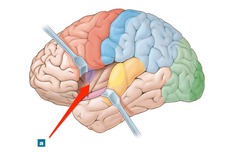
Insula

answer
People suffering damage to a brain region rucked within get frontal cortex are reportedly able to effortlessly quit smoking indicating that this brain region is also involved in addiction.



